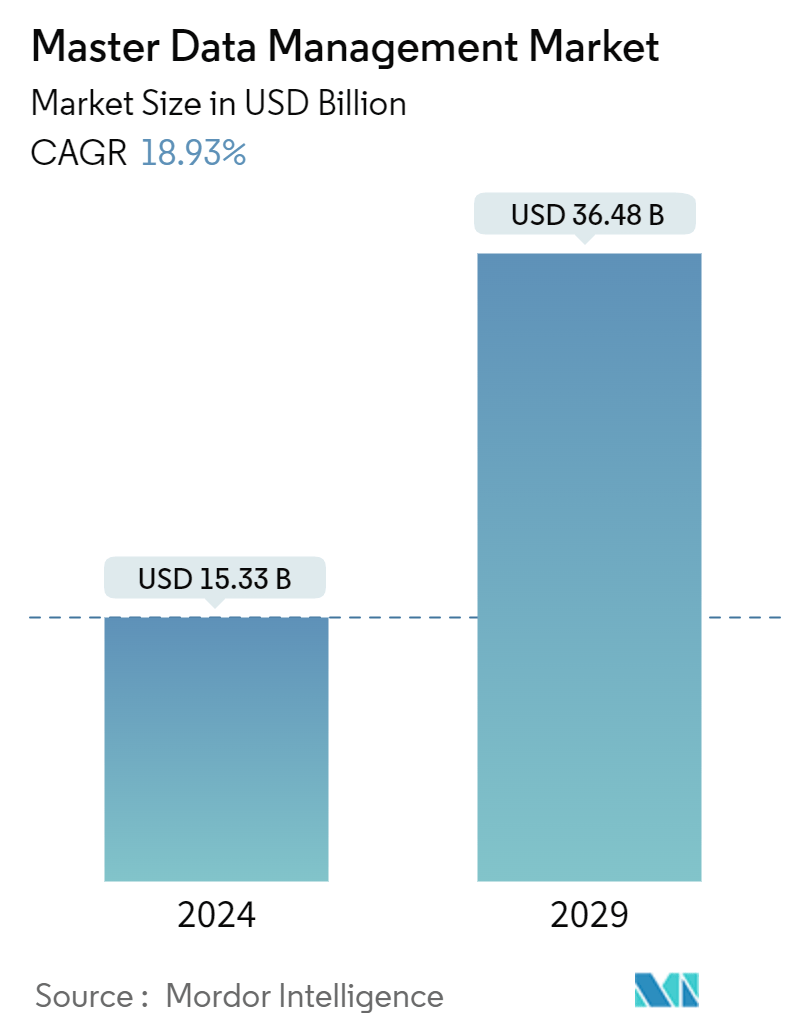Market Size of Master Data Management Industry

| Study Period | 2019 - 2029 |
| Market Size (2024) | USD 15.33 Billion |
| Market Size (2029) | USD 36.48 Billion |
| CAGR (2024 - 2029) | 18.93 % |
| Fastest Growing Market | Asia-Pacific |
| Largest Market | North America |
| Market Concentration | Low |
Major Players
*Disclaimer: Major Players sorted in no particular order |
Master Data Management Market Analysis
The Master Data Management Market size is estimated at USD 15.33 billion in 2024, and is expected to reach USD 36.48 billion by 2029, growing at a CAGR of 18.93% during the forecast period (2024-2029).
The Master Data Management Market size is estimated at USD 15.33 billion in 2024, and is expected to reach USD 36.48 billion by 2029, growing at a CAGR of 18.93% during the forecast period (2024-2029).
The demand for data compliance and the growing usage of master data management solutions in prominent companies to improve business operations would likely fuel revenue growth.
- To deliver information that can be relied upon for decision-making and consumer outreach, tools for master data management and data governance are essential. This is because a broader range of systems, IT specialists, and users from businesses and partner organizations create and access data.
- In recent years, organizations have become more aware of their data, which is crucial to the success or failure of an organization's most important business activities. The Internet of Things (IoT), interconnected, connected devices, cloud computing, mobility, and digitalization have all boosted data flow and volume, combined with the availability of less expensive storage, pushing organizations to preserve practically everything. Unfortunately, this strategy has caused sensitive, critical, and mission-critical data points to have varying parameters, commonly creating dark data swamps.
- The switch from segregated data environments to a consolidated master data set is now being investigated and tried by many businesses. The purpose of such master data initiatives, also known as master data management (MDM) projects, is to generate a golden copy of crucial company data for consumption and to discover, validate, and address data errors near the source as feasible. A successful MDM program enables data consistency, completeness, and correctness. However, installing an MDM program can only guarantee success if business-supported data management initiatives are implemented concurrently.
- The market is growing due to recent innovations in machine learning (ML), big data, and artificial intelligence (AI). In addition to offering access to enormous datasets, this technology offers new technological possibilities for data processing and storage. As new technologies' capacity for handling data from several domains and perspectives has increased, customers have a wide range of expectations. The most frequent request has been to combine master data management systems with big data, analytics, and business intelligence technologies.
- However, implementation, data security, and privacy issues constrain market revenue. Due to strict laws and extensive business requirements, MDM implementation might be challenging. Furthermore, firms are progressively integrating technologies, which makes them prone to security flaws and assaults. Users resist MDM solutions because they are concerned about losing critical personal data. These issues are inhibiting MDM solution adoption and limiting the market's revenue growth.
Master Data Management Industry Segmentation
To maintain the consistency, correctness, stewardship, semantic consistency, and accountability of the enterprise's official shared master data assets, business and information technology collaborate through the discipline of master data management (MDM), which is facilitated by technology.
The master data management market is segmented by component (software, service), by deployment model (on-premise, cloud), by enterprise size (large enterprises, small and medium enterprises), by application (supplier, product, customer), by industry vertical (IT and telecommunication, BFSI, healthcare, government, retail, manufacturing, education), and geography (North America, Europe, Asia-Pacific, Middle East and Africa, Rest of the World). The market sizes and forecasts are provided in terms of value in USD for all the above segments.
| By Component | |
| Software | |
| Service |
| By Deployment Model | |
| On-premise | |
| Cloud |
| By Enterprise Size | |
| Large Enterprises | |
| Small and Medium Enterprises |
| By Application | |
| Supplier | |
| Product | |
| Customer | |
| Other Applications |
| By Industry Vertical | |
| IT and Telecommunication | |
| BFSI | |
| Healthcare | |
| Government | |
| Retail | |
| Manufacturing | |
| Education | |
| Other Industry Verticals |
| By Geography*** | |
| North America | |
| Europe | |
| Asia | |
| Australia and New Zealand | |
| Latin America | |
| Middle East and Africa |
Master Data Management Market Size Summary
The master data management (MDM) market is poised for significant growth, driven by the increasing need for data compliance and the adoption of MDM solutions by major corporations to enhance business operations. As organizations become more data-conscious, the shift from fragmented data environments to consolidated master data sets is gaining traction. This transition aims to create a reliable "golden copy" of essential business data, ensuring consistency, completeness, and accuracy. The market's expansion is further fueled by advancements in machine learning, big data, and artificial intelligence, which offer new opportunities for data processing and storage. However, challenges such as implementation complexities, data security, and privacy concerns continue to pose obstacles to market growth.
The MDM industry is experiencing a shift towards cloud-based solutions, offering speed and flexibility as businesses increasingly migrate applications and data to the cloud. Cloud-native MDM solutions are expected to provide advantages over on-premise systems, particularly in integrating with cloud-sourced data and applications. North America holds the largest market share, supported by the region's technological advancements and the presence of major MDM players like IBM, Oracle, and Informatica Inc. These companies are expanding their global presence and enhancing their product offerings to capture a larger market share. The market remains highly fragmented, with key players focusing on international expansion and strategic partnerships to drive growth and profitability.
Master Data Management Market Size - Table of Contents
-
1. MARKET INSIGHTS
-
1.1 Market Overview
-
1.2 Industry Attractiveness - Porter's Five Forces Analysis
-
1.2.1 Bargaining Power of Suppliers
-
1.2.2 Bargaining Power of Buyers/Consumers
-
1.2.3 Threat of New Entrants
-
1.2.4 Threat of Substitute Products
-
1.2.5 Intensity of Competitive Rivalry
-
-
1.3 Assessment of Impact of COVID-19 on the Market
-
-
2. MARKET SEGMENTATION
-
2.1 By Component
-
2.1.1 Software
-
2.1.2 Service
-
-
2.2 By Deployment Model
-
2.2.1 On-premise
-
2.2.2 Cloud
-
-
2.3 By Enterprise Size
-
2.3.1 Large Enterprises
-
2.3.2 Small and Medium Enterprises
-
-
2.4 By Application
-
2.4.1 Supplier
-
2.4.2 Product
-
2.4.3 Customer
-
2.4.4 Other Applications
-
-
2.5 By Industry Vertical
-
2.5.1 IT and Telecommunication
-
2.5.2 BFSI
-
2.5.3 Healthcare
-
2.5.4 Government
-
2.5.5 Retail
-
2.5.6 Manufacturing
-
2.5.7 Education
-
2.5.8 Other Industry Verticals
-
-
2.6 By Geography***
-
2.6.1 North America
-
2.6.2 Europe
-
2.6.3 Asia
-
2.6.4 Australia and New Zealand
-
2.6.5 Latin America
-
2.6.6 Middle East and Africa
-
-
Master Data Management Market Size FAQs
How big is the Master Data Management Market?
The Master Data Management Market size is expected to reach USD 15.33 billion in 2024 and grow at a CAGR of 18.93% to reach USD 36.48 billion by 2029.
What is the current Master Data Management Market size?
In 2024, the Master Data Management Market size is expected to reach USD 15.33 billion.

